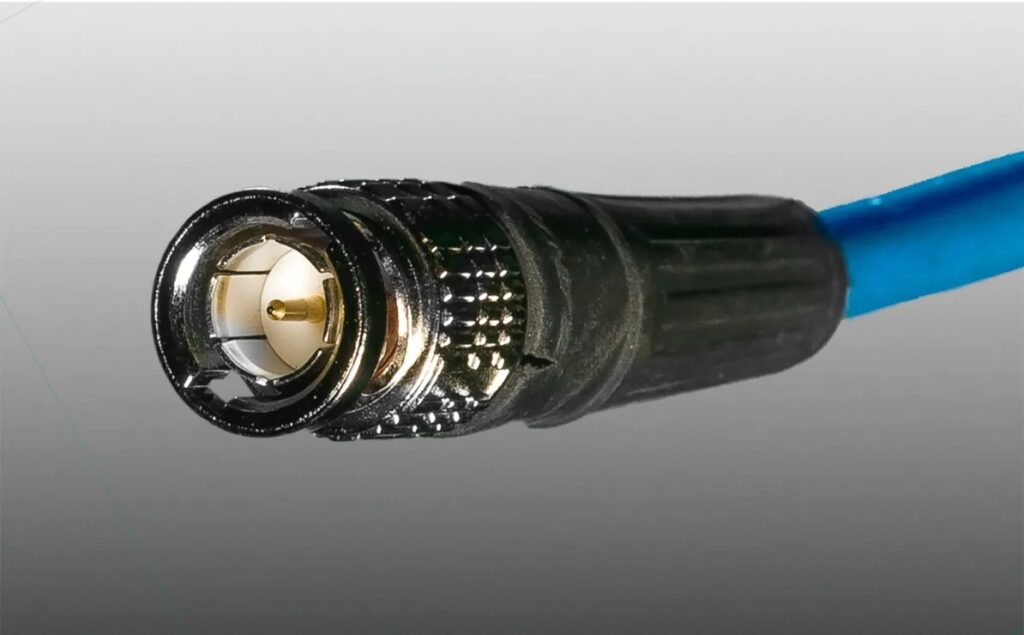HDMI and SDI are both video interfaces; one being used by consumers while the other by professionals. Let’s explore SDI.
SDI (Serial Digital Interface)
SMPTE introduced SDI as part of their specification back in 1989.
SDI connections consist of single pin connections made using either locking BNC connectors or non-locking mini BNC plugs, commonly known as British Naval Connectors. BNC was first used on ships at sea where reliable radio signal reception was of critical importance.

As higher resolution formats have been added to professional video cameras, SDI has evolved into HD SDI (high-definition serial digital interface), carrying with it a nominal data rate of 1.485 gigabits per second (Gbps).
Dual Link SDI was initially developed to accommodate data rates up to 2.970 Gb/s with two cables.
In 2006, 3G-SDI replaced Dual Link SDI by using only one cable – making it more reliable – while offering an expected data rate of 2.970 Gbps.
By 2015, SMPTE approved specifications for 6G-SDI and 12G-SDI due to increased 4K video production. 6G-SDI carried a nominal data rate of 6 Gbps while 12G-SDI moved 12 Gbps; both carried more streams of data due to higher resolutions and frame rates; these cables come equipped with 75-ohm coaxial cable to ensure you obtain optimal performance. When purchasing SDI cables make sure 75-ohm is specifically mentioned within their specifications for maximum results.

The SDI module shown above allows Atomos Ninja V HDMI recorders to play back video onto an SDI monitor without having to convert HDMI signals into SDI, thus recording SDI input from professional video cameras with SDI outputs (since its BNC connector would be too big to fit within compact DSLR and mirrorless cameras).
Video and Audio
SDI video transmission is uncompressed and unencrypted, while its audio support up to 16 discrete channels, with 300 meters (980 feet). Professionals often prefer this cable length due to its locking cables enabling cameras to be situated nearly one thousand feet from recording studios or recorders.
HDMI (High Definition Multimedia Interface) was initially created to connect DVD and Blu-ray players and gaming consoles to HD televisions, replacing red, white, and yellow connections found on VHS players/recorders.
HDMI has become the go-to cable for high-end video cameras such as DSLR and mirrorless models.
HDMI connectors come in three sizes; type A for full HDMI, C for mini HDMI, and D for micro HDMI. All three types carry equal amounts of data but differ significantly in that their connectors do not lock into place – here is what each type looks like.
Cable capacities
Data rates differ depending on the type of HDMI cable being used. All HDMI cables come equipped with three distinct connectors which may prove confusing; just persevere!
HDMI 1.4 standard cables (excluding connectors ) can support both 1080i and 720p video and audio playback while high-speed cables provide access to 1080p, 4K30Hz, 3D, and Deep Color capabilities.
In 2015, HDMI 2.0 specifications were published and support 4K60p with Rec 2020 and HDR formats. 2018 saw the introduction of HDMI 2.1 which can handle 48 Gbps at 120Hz for 4K, 5K, 8K, 10K formats.
HDMI Is Prosumer
Although HDMI meets the high-volume data handling spec of 2.1, it remains an accessible way of managing video for consumers. Connectors do not lock but there are workarounds. However, one major drawback of HDMI cables is their short length: 50 feet is its maximum limit.
HDMI connections are standard on DSLR and mirrorless still cameras, limiting video production from still cameras without hindering it.
Care must be taken not to unplug the connector and cable length may become an issue; however, modern still cameras often shoot 4K video at up to 120 frames per second for still photos taken using such cameras – an impressive amount of capacity from an instrument meant primarily for taking still photographs.
Important notes… 4K30Hz does not refer to the frame rate of video but rather the refresh rate built into your monitor; higher refresh rates make for smoother video content.
My best example of the difference this makes can be seen when watching a major league baseball game: when pitchers throw at over 100 miles an hour, their pitches appear as blurs on a 30Hz TV screen; as more accurate refresh rates increase, so more clearly fast moving objects appear overall.
